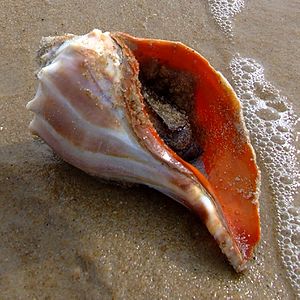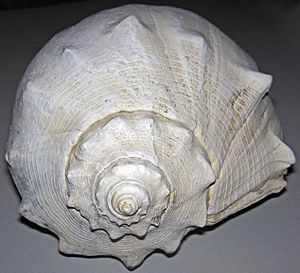Knobbed whelk facts for kids
Quick facts for kids Knobbed whelk |
|
|---|---|
 |
|
| Scientific classification | |
| Kingdom: | |
| Phylum: | |
| Class: | |
| Order: |
Sorbeoconcha
|
| Family: |
Melongenidae
|
| Genus: |
Busycon
|
| Species: |
B. carica
|
| Binomial name | |
| Busycon carica (Gmelin, 1791)
|
|
The knobbed whelk is a very large sea snail. It's a type of mollusk that lives in the ocean. These snails are predators, meaning they hunt other animals for food. The knobbed whelk can grow up to 12 inches (305 mm) long. This makes it one of the biggest whelks around!
Contents
Where Do Knobbed Whelks Live?
Knobbed whelks are found along the North Atlantic coast of North America. You can find them from Cape Cod, Massachusetts down to northern Florida. They are especially common along the coast of Georgia.
This interesting sea snail is so special that it's the official state shell for both New Jersey and Georgia.
What Does a Knobbed Whelk Shell Look Like?
Most knobbed whelk shells are "right-handed," which is called dextral. If you hold the shell with the pointy spiral end up and the opening facing you, the opening will be on the right side.
The shell is very thick and strong. It has six coils that spiral in a clockwise direction. The color of the shell is usually ivory or a light gray. The large opening, called the aperture, is bright orange inside.
How Do Knobbed Whelks Live?
Knobbed whelks live below the low tide mark in the ocean. They are migratory, meaning they move between deep and shallow water. Their movements depend on the time of year.
During very hot summers and cold winters, these sea snails go to deeper water. They can live at depths of up to 48 meters (about 157 feet). In the milder weather of spring and fall, they move to shallow water. You can find them on mud flats and sand flats close to shore.
When they are in the shallow-water mud flats, whelks hunt for food. They like to prey on oysters, clams, and other types of mollusks.
How Do People Use Knobbed Whelks?
Just like conchs, knobbed whelks are sometimes eaten by people. Their meat can be used in salads, burgers, fritters, and chowders.
The shells of knobbed whelks can also be used to make a natural bugle. To do this, the tip of the spire (the pointy top of the shell) is cut off. This creates a mouthpiece for the instrument.
Long ago, American Indians used knobbed whelk shells. They made them into wampum, which were special shell beads. These beads were used for trade in North America.
Images for kids







